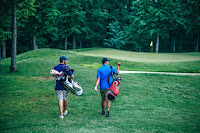Your focus is gone, your strength has waned and your muscles have left you sore to the core. What can the average golfer do to recover after playing too much golf?
Some golfers say, no matter how much golf they play it is never enough! Recently, the Myrtle Beach Patriots attempted to play one-hundred holes of golf to benefit disabled veteran and their families - a noble cause.
After a long, and tiring, golf season, Phil Mickelson mentioned after the Ryder Cup, that he believed he "made a bit of a mistake" by playing too many events in a row. As amateur golfers, we may not play in tournament after tournament, but the same might be said if we decide on another nine holes after a grueling eighteen comes to a close.
Some golfers say, no matter how much golf they play it is never enough! Recently, the Myrtle Beach Patriots attempted to play one-hundred holes of golf to benefit disabled veteran and their families - a noble cause.
After a long, and tiring, golf season, Phil Mickelson mentioned after the Ryder Cup, that he believed he "made a bit of a mistake" by playing too many events in a row. As amateur golfers, we may not play in tournament after tournament, but the same might be said if we decide on another nine holes after a grueling eighteen comes to a close.
Golf for Beginners tends to agree with Mickelson...twenty-four golf starts in a row for a PGA Tour pro are way too many rounds...especially for a more seasoned player who is no longer in his twenties and who quietly suffers from Psoriatic Arthritis. In this article, we give you three ways to stay in good health and bounce back when your body says no.
1. Hydration and Food: Sounds simple enough but most golfers don't drink enough water and don't grab snacks that will energize them during a round. Try a drink that has low sugar content and electrolytes like Vitamin Water Zero. I also keep healthy snacks in my golf bag - a snack at around the tenth hole is a fruit and nut bar or a 10th Tee Golf Nutrition bar.
1. Hydration and Food: Sounds simple enough but most golfers don't drink enough water and don't grab snacks that will energize them during a round. Try a drink that has low sugar content and electrolytes like Vitamin Water Zero. I also keep healthy snacks in my golf bag - a snack at around the tenth hole is a fruit and nut bar or a 10th Tee Golf Nutrition bar.
2. Get Loose: Make sure you stretch your muscles before you hit your first shot of the day and keep loose throughout the day. If you are playing golf several days in a row, follow the same routine and don't overwork yourself on the driving range. Practice correctly with most of your shots being chips, pitches, and putts.
3. Rest: No matter how many holes of golf you will be playing, take time to rest both body and mind in between shots and rounds - you need both to function well for your best chances of success.
Feel free to comment at the bottom of our Golf for Beginners blog.
3. Rest: No matter how many holes of golf you will be playing, take time to rest both body and mind in between shots and rounds - you need both to function well for your best chances of success.
Feel free to comment at the bottom of our Golf for Beginners blog.




















